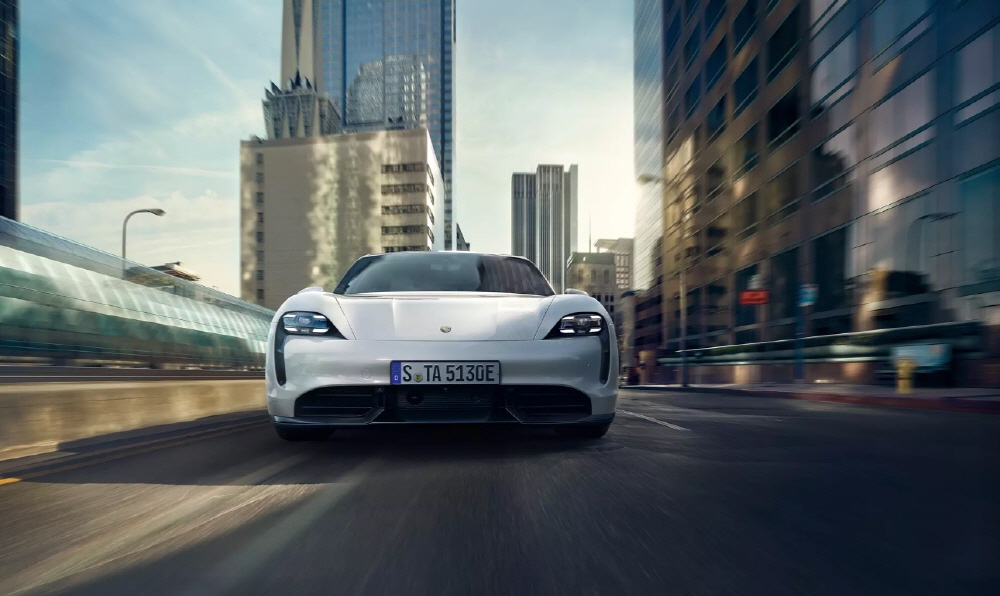
Four years after the concept car was announced as the Mission E, Porsche’s first electric powered vehicle, the Porsche Taycan, was finally released.
Porsche’s first pure electric car is a four-seater with ample space in the rear seat and four doors. Two permanent magnet synchronous motors are mounted before and after the vehicle body, each driving the front and rear wheels. It is said that the solenoid coil is used to increase the output and torque without changing the volume. Normally, permanent magnet synchronous motors have a weakness of being less efficient at high rotations, but Porsche has taken a method of lowering the motor rotation when driving at high speeds by combining a two-speed transmission. The first gear enables strong start acceleration, and the second gear allows the range to be increased while suppressing power consumption.


Lithium-ion batteries are placed between the front and rear wheels, which is on the bottom of the body. However, I didn’t put the battery where it touched the back seat feet. Thanks to this, the rear seat occupants secured habitability to sit comfortably without getting caught in their legs, while also realizing a low roofline like a sports sedan.
The first models released are the Taycan Turbo S and the Taycan Turbo. The car name has a turbo, but of course, a turbocharger is not installed. For Porsche, the Turbo means not only a supercharger, but a high-performance model. The Taycan plans to add an entry-level model later this year that doesn’t have a Turbo on its car name.
The Taycan Turbo and Turbo S have different front-mounted motor performance. If all of them activate the sudden start function, the power will temporarily increase due to overboost. The Taycan Turbo has a maximum output of 680 hp, a maximum torque of 850 Nm, and a zero back of 3.2 seconds. The Taycan Turbo S has 761 horsepower, 1,050 Nm, and zero-back in 2.8 seconds.

The battery pack capacity is 93.4kWh. The range is 450 km for Turbo and 412 km for Turbo S. Of course, the distance may be shorter depending on other specifications such as options. The front and rear motors apply up to 265 kW of regenerative brakes to the front and rear wheels, so according to Porsche, 90% of daily use does not require hydraulic brakes to be applied.
The Taycan is the first vehicle in the world to adopt an 800V high-voltage system, so charging up to 270kW takes only 22 minutes and 30 seconds from 5% to 80% of the remaining battery power.
The interior and exterior design inherits Porsche’s DNA, while offering a glimpse of new tastes. The body size is 4,963mm in length, 1,966mm in width, and the overall height is 1,381mm for the turbo, and the turbo S is a little lower at 1,378mm. The wheelbase is 2,900m. The weight is 2,305kg for Turbo and 2,295kg for Turbo S.

The dashboard is equipped with a 10.9-inch infotainment touchscreen next to the curved instrument panel. The passenger seat screen is optional. The air conditioner can also be operated with a touch, and if you call it hey Porsche, you can also operate it with voice commands.
Taycan said that it does not provide any skins made of animal skins for the skin of the sheep, but instead uses innovative recycled materials. Also, since there are no engines in the front and rear, the Taycan has a cargo compartment before and after the body. The capacity is 81 liters under the bonnet and 366 liters in the rear. By the end of 2020, models with wider and more convenient luggage compartments and hatch gates will also appear.
The Taycan Turbo is priced at $153,310 and the Taycan Turbo S is priced at $178,610. It is said that over 20,000 people around the world have already paid deposits. Related information can be found here .


















Add comment